河南历史文化旅游景点介绍
河南古镇旅游景点大全
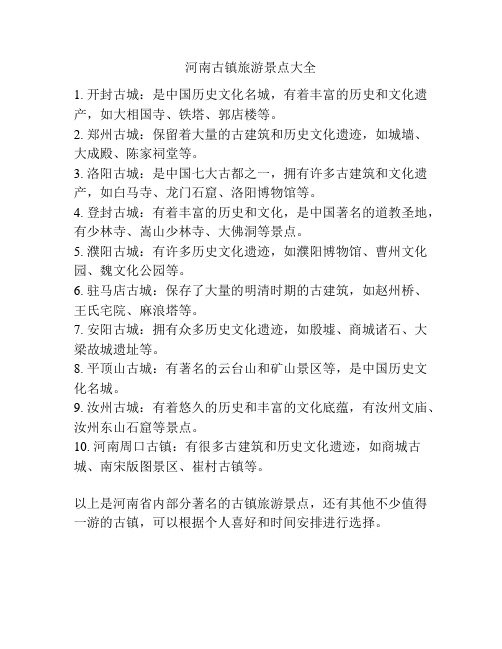
河南古镇旅游景点大全
1. 开封古城:是中国历史文化名城,有着丰富的历史和文化遗产,如大相国寺、铁塔、郭店楼等。
2. 郑州古城:保留着大量的古建筑和历史文化遗迹,如城墙、大成殿、陈家祠堂等。
3. 洛阳古城:是中国七大古都之一,拥有许多古建筑和文化遗产,如白马寺、龙门石窟、洛阳博物馆等。
4. 登封古城:有着丰富的历史和文化,是中国著名的道教圣地,有少林寺、嵩山少林寺、大佛洞等景点。
5. 濮阳古城:有许多历史文化遗迹,如濮阳博物馆、曹州文化园、魏文化公园等。
6. 驻马店古城:保存了大量的明清时期的古建筑,如赵州桥、王氏宅院、麻浪塔等。
7. 安阳古城:拥有众多历史文化遗迹,如殷墟、商城诸石、大梁故城遗址等。
8. 平顶山古城:有著名的云台山和矿山景区等,是中国历史文化名城。
9. 汝州古城:有着悠久的历史和丰富的文化底蕴,有汝州文庙、汝州东山石窟等景点。
10. 河南周口古镇:有很多古建筑和历史文化遗迹,如商城古城、南宋版图景区、崔村古镇等。
以上是河南省内部分著名的古镇旅游景点,还有其他不少值得一游的古镇,可以根据个人喜好和时间安排进行选择。
河南历史文化旅游景点介绍

1.少林寺少林寺位于登封市西12公里处的嵩山五乳峰下,因寺处嵩山少室密林之中,故名“少林寺”,意为“深藏于少室山下密林中的寺院”。
少林寺建于北魏太和十九年(公元495年),是孝文帝为安顿印度高僧跋陀而建。
北魏孝昌三年(公元527年),印度高僧菩提达摩来到少林,在少室山五乳峰一天然石洞面壁九年,首传禅宗。
是我国久负盛名的佛教寺院,声誉显赫的禅宗祖庭,少林功夫的发祥地。
“少林寺景区”被授予中国,8月1日,包括少林寺常住院、和在内的“”被列为。
Shao Lin Temple is situated at the western foot of Songshan Mountain, 12 kilometers northwest to Dengfeng City, Henan Province. Against the backdrop of Wuru Peak of Shaoshi Mountain, it is surrounded with forests and hills as its natural defense. The “Shao”in “Shaolinsi”refers to “Shaoshi Mountain”; “lin”means "forest” and si “temple”. The name of Shaolin Temple literally means "temple in the woods of Shaoshi Mountain". Shaolin Temple was established in 495A.D. The then Emperor Xiaowen of the Northern Wei dynasty (386-557) had the temple built to accommodate the Indian master Batuo (Buddhabhadra). In 527, the Indian monk Bodhidharma arrived at Shaolin Temple. He spent nine years meditating in a cave of the Wuru Peak and initiated the Chinese Chan tradition at Shaolin Temple. Thereafter, Bodhidharma was honored as the first Patriarch of Chan Buddhism. As Chinese Kungfu also originated from Shaolin Temple, it has been recognized as the origin of Chan Buddhism and the cradle of Kungfu. Shaolin Temple was listed as the national AAAAA tourist scenic spot in 2007, and its famed were inscribed as a in 2010 as part of the "."2. 龙门石窟龙门石窟位于洛阳市区南面12公里处,是与大同云岗石窟、敦煌千佛洞石窟齐名的我国三大石窟之一。
河南旅游景点简介

河南旅游景点简介
河南是一个历史悠久、文化底蕴深厚的省份,拥有众多世界文化遗产和自然景观。
以下是一些著名的河南旅游景点简介:
1. 郑州黄河风景带:作为河南省的省会,郑州市位于黄河中游地区,河畔风光秀丽。
游客可以欣赏到壮观的黄河风光,还可以乘坐游船畅游黄河,感受浩渺的大自然景观。
2. 郑州禅宗兴教圣地:位于郑州市郊外的嵩山少林寺和开封市的妙应寺是中国佛教禅宗的发源地之一,具有深厚的佛教文化底蕴。
来这里的游客可以感受到佛教禅宗的精神内涵,同时还可以欣赏到古老的建筑和独特的武术表演。
3. 郑州航空航天博物馆:这是中国唯一的大型航空航天博物馆,是航空航天爱好者的天堂。
馆内展示了大量的航空航天器材和模型,还有丰富的历史资料和科普展览,让游客对航空航天事业有更深入的了解。
4. 洛阳龙门石窟:位于洛阳市郊外的龙门山上,是中国最著名的石窟之一。
石窟内有许多精美的佛像和壁画,展示了中国古代石刻艺术的瑰宝。
游客可以在这里感受到悠久的佛教文化和艺术氛围。
5. 开封庙会:每年的春节期间,在开封市举办的开封庙会是河南最盛大的民俗文化活动之一。
庙会上有各种各样的传统表演、手工艺品和美食,吸引了大量的游客。
除了以上景点,河南还有许多其他著名的景点,如洛阳白马寺、安阳殷墟、焦作云台山等。
无论是自然景观还是人文景观,河南都有很多值得游览的地方。
河南最值得去的十个地方
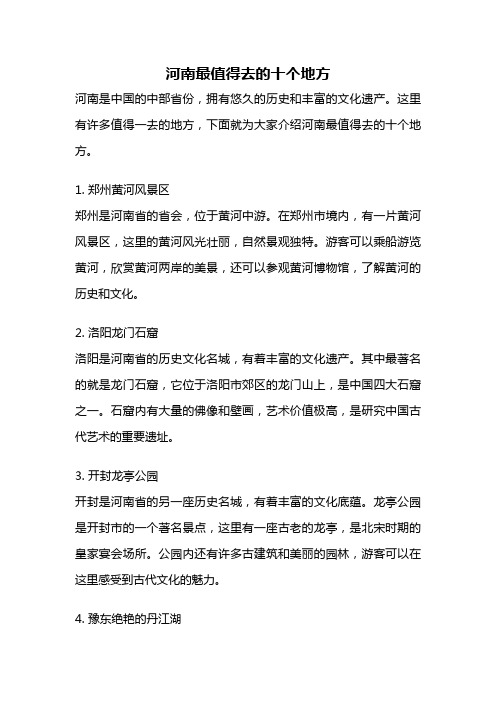
河南最值得去的十个地方河南是中国的中部省份,拥有悠久的历史和丰富的文化遗产。
这里有许多值得一去的地方,下面就为大家介绍河南最值得去的十个地方。
1. 郑州黄河风景区郑州是河南省的省会,位于黄河中游。
在郑州市境内,有一片黄河风景区,这里的黄河风光壮丽,自然景观独特。
游客可以乘船游览黄河,欣赏黄河两岸的美景,还可以参观黄河博物馆,了解黄河的历史和文化。
2. 洛阳龙门石窟洛阳是河南省的历史文化名城,有着丰富的文化遗产。
其中最著名的就是龙门石窟,它位于洛阳市郊区的龙门山上,是中国四大石窟之一。
石窟内有大量的佛像和壁画,艺术价值极高,是研究中国古代艺术的重要遗址。
3. 开封龙亭公园开封是河南省的另一座历史名城,有着丰富的文化底蕴。
龙亭公园是开封市的一个著名景点,这里有一座古老的龙亭,是北宋时期的皇家宴会场所。
公园内还有许多古建筑和美丽的园林,游客可以在这里感受到古代文化的魅力。
4. 豫东绝艳的丹江湖丹江湖位于河南省东部,是中国最大的人工湖之一。
湖水清澈湛蓝,周围的山峦环抱,景色十分优美。
游客可以在湖上划船,欣赏湖光山色,还可以品尝到当地的特色美食。
5. 新乡尧山新乡是河南省的一个地级市,尧山是新乡市的一个著名景点。
尧山位于新乡市区的西南部,是中国道教的发源地之一。
山上有许多古建筑和文化遗址,是研究中国古代文化的重要场所。
6. 濮阳殷墟濮阳市是河南省的一个地级市,殷墟是濮阳市的一个著名景点。
殷墟是中国商朝的遗址,是中国历史上最早的都城遗址之一。
在这里,游客可以参观到商朝的宫殿、祭坛和墓葬,了解商朝的历史和文化。
7. 平顶山少林寺平顶山是河南省的一个地级市,少林寺是平顶山市的一个著名景点。
少林寺是中国佛教禅宗的发源地之一,也是世界上最著名的佛教寺庙之一。
在这里,游客可以参观到古老的寺庙和佛塔,还可以观看到僧人的功夫表演。
8. 信阳明山湖信阳市是河南省的一个地级市,明山湖是信阳市的一个著名景点。
明山湖是中国最大的淡水湖之一,湖水清澈见底,周围的山峦环抱,景色优美。
河南著名旅游景点大全

河南著名旅游景点大全
河南是中国的中部省份,拥有丰富的历史文化和自然景观资源。
以下是一些著名的旅游景点:
1. 郑州:省会城市,有千年商业街古都商城、黄河风情园、河南省博物馆等。
2. 郑州大学:中国著名综合性大学,校园环境优美,文化氛围浓厚。
3. 开封:历史悠久的古都,有金明池、龙亭、大相国寺、北宋铁塔等。
4. 登封:有少林寺、嵩山、伏牛山等景点,是佛教圣地和道教名山。
5. 洛阳:有龙门石窟、洛阳白马寺、洛阳博物馆等,被誉为“东方文化之都”。
6. 洛阳白马寺:中国佛教四大名刹之一,有梁武帝驾云拜佛的传说。
7. 河南博物院:位于开封,是全国知名的博物馆,收藏了大量珍贵文物。
8. 丹江口水库:中国第一大水库,被誉为“南水北调”的重要水源地。
9. 鹳雀楼:位于开封,是中国古代建筑的代表之一,素有“华
夏第一楼”之称。
10. 庙堂街:位于郑州,是河南最古老、最有名的商业街之一。
11. 匡庐:位于郑州,是河南最大的古建筑群,有唐尧庙和汉
高祖庙。
12. 白云山:位于郑州,是风景秀丽的名山,有白云寺和白云
飞瀑等。
13. 千佛洞:位于洛阳,是中国最大的石窟之一,有大量精美
的佛像和壁画。
14. 嵩山少林寺:中国最古老的佛教寺庙之一,被誉为“中华武术的发源地”。
15. 伊河谷:位于洛阳,是中国四大峡谷之一,有壶口瀑布和
千龙峡等景点。
以上只是河南省内一部分著名旅游景点,还有许多其他值得一游的景点等待您的探索。
河南最值得去的十个地方

河南最值得去的十个地方河南是一个历史悠久、文化底蕴深厚的省份,拥有许多令人难以忘怀的旅游景点。
下面将介绍河南最值得去的十个地方。
一、郑州城市广场郑州是河南的省会,也是河南最繁华的城市之一。
郑州城市广场是郑州的地标性建筑,是郑州市的中心区域,集购物、娱乐、观光于一体。
在这里,你可以感受到现代化城市的繁荣和都市生活的激情。
二、洛阳龙门石窟洛阳是中国四大古都之一,拥有丰富的历史文化遗产。
龙门石窟是世界文化遗产,是中国石窟艺术的瑰宝。
在这里,你可以欣赏到千余尊精美的佛像,感受到古代艺术的魅力。
三、开封庙会开封是中国历史文化名城,庙会是开封的传统活动之一。
每年春节期间,开封庙会吸引了大量游客和商贩。
在这里,你可以品尝到各种美食、购买到各种特色商品,并欣赏到传统的表演和游乐项目。
四、郑州黄河风景区黄河是中国的母亲河,郑州黄河风景区位于郑州市郊区,是郑州市民休闲娱乐的好去处。
在这里,你可以欣赏到黄河的壮丽景色,感受到黄河的恢弘气势,还可以进行各种水上活动和游玩项目。
五、洛阳白马寺白马寺是中国佛教四大名刹之一,也是中国现存最早的佛教寺庙之一。
寺内保存着大量的佛教文物,包括佛像、经文和佛教艺术品等。
在这里,你可以感受到佛教文化的庄严和宁静,体验到心灵的净化和寻找内心平静的感觉。
六、开封清明上河园清明上河园是开封市的著名景点,是一座以北宋都城开封为背景的历史文化公园。
在这里,你可以了解到北宋社会的生活情景,感受到北宋文化的魅力,还可以欣赏到精美的建筑和园林。
七、郑州博物馆郑州博物馆是河南最大的综合性博物馆,馆内陈列着大量的历史文物和艺术品。
在这里,你可以了解到河南的历史和文化,欣赏到珍贵的文物和艺术品,增长自己的知识和见识。
八、洛阳少林寺少林寺是中国佛教禅宗的发源地,也是中国武术的发源地之一。
在这里,你可以参观到少林寺的建筑和寺庙,了解到少林寺的历史和文化,还可以观看到少林武僧的表演和武术功夫。
九、开封大宋皇城大宋皇城是开封市的标志性建筑,是中国古代皇城建筑的典范。
河南著名的旅游景点
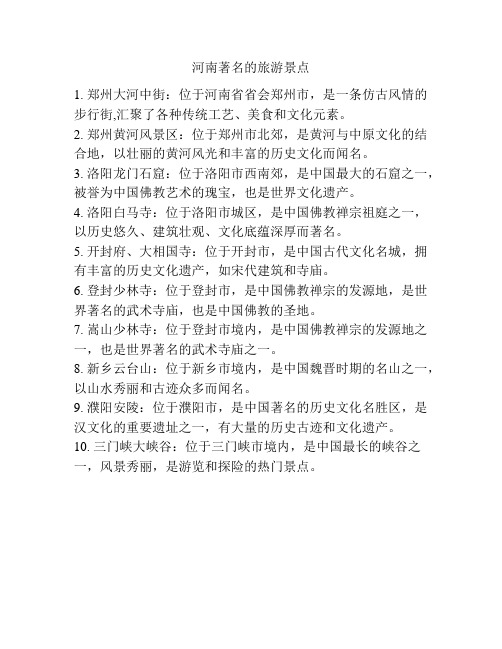
河南著名的旅游景点
1. 郑州大河中街:位于河南省省会郑州市,是一条仿古风情的步行街,汇聚了各种传统工艺、美食和文化元素。
2. 郑州黄河风景区:位于郑州市北郊,是黄河与中原文化的结合地,以壮丽的黄河风光和丰富的历史文化而闻名。
3. 洛阳龙门石窟:位于洛阳市西南郊,是中国最大的石窟之一,被誉为中国佛教艺术的瑰宝,也是世界文化遗产。
4. 洛阳白马寺:位于洛阳市城区,是中国佛教禅宗祖庭之一,以历史悠久、建筑壮观、文化底蕴深厚而著名。
5. 开封府、大相国寺:位于开封市,是中国古代文化名城,拥有丰富的历史文化遗产,如宋代建筑和寺庙。
6. 登封少林寺:位于登封市,是中国佛教禅宗的发源地,是世界著名的武术寺庙,也是中国佛教的圣地。
7. 嵩山少林寺:位于登封市境内,是中国佛教禅宗的发源地之一,也是世界著名的武术寺庙之一。
8. 新乡云台山:位于新乡市境内,是中国魏晋时期的名山之一,以山水秀丽和古迹众多而闻名。
9. 濮阳安陵:位于濮阳市,是中国著名的历史文化名胜区,是汉文化的重要遗址之一,有大量的历史古迹和文化遗产。
10. 三门峡大峡谷:位于三门峡市境内,是中国最长的峡谷之一,风景秀丽,是游览和探险的热门景点。
河南省著名的旅游景点
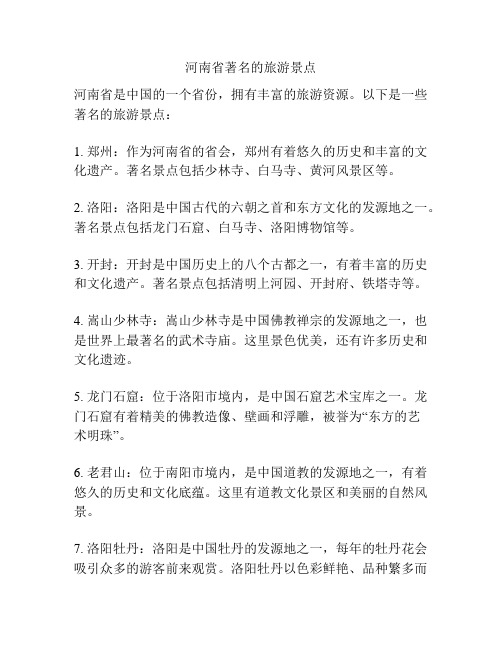
河南省著名的旅游景点
河南省是中国的一个省份,拥有丰富的旅游资源。
以下是一些著名的旅游景点:
1. 郑州:作为河南省的省会,郑州有着悠久的历史和丰富的文化遗产。
著名景点包括少林寺、白马寺、黄河风景区等。
2. 洛阳:洛阳是中国古代的六朝之首和东方文化的发源地之一。
著名景点包括龙门石窟、白马寺、洛阳博物馆等。
3. 开封:开封是中国历史上的八个古都之一,有着丰富的历史和文化遗产。
著名景点包括清明上河园、开封府、铁塔寺等。
4. 嵩山少林寺:嵩山少林寺是中国佛教禅宗的发源地之一,也是世界上最著名的武术寺庙。
这里景色优美,还有许多历史和文化遗迹。
5. 龙门石窟:位于洛阳市境内,是中国石窟艺术宝库之一。
龙门石窟有着精美的佛教造像、壁画和浮雕,被誉为“东方的艺
术明珠”。
6. 老君山:位于南阳市境内,是中国道教的发源地之一,有着悠久的历史和文化底蕴。
这里有道教文化景区和美丽的自然风景。
7. 洛阳牡丹:洛阳是中国牡丹的发源地之一,每年的牡丹花会吸引众多的游客前来观赏。
洛阳牡丹以色彩鲜艳、品种繁多而
闻名,被誉为“中国牡丹之都”。
以上只是列举了一些河南省著名的旅游景点,实际上河南省还有许多其他优美的自然风景和丰富的文化遗产,值得游客探索和发现。
河南古镇旅游景点
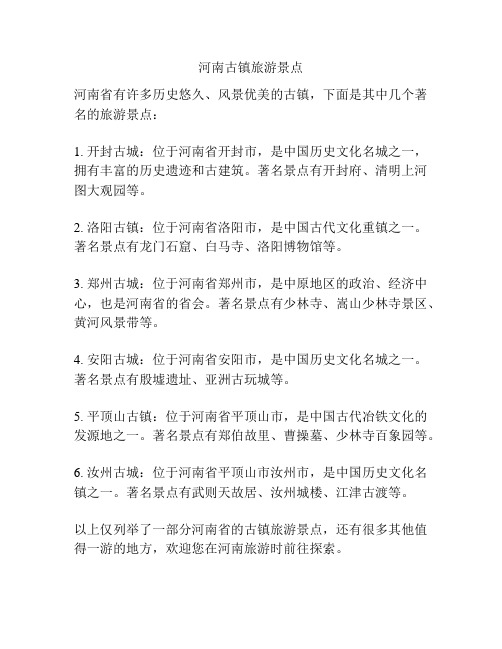
河南古镇旅游景点
河南省有许多历史悠久、风景优美的古镇,下面是其中几个著名的旅游景点:
1. 开封古城:位于河南省开封市,是中国历史文化名城之一,拥有丰富的历史遗迹和古建筑。
著名景点有开封府、清明上河图大观园等。
2. 洛阳古镇:位于河南省洛阳市,是中国古代文化重镇之一。
著名景点有龙门石窟、白马寺、洛阳博物馆等。
3. 郑州古城:位于河南省郑州市,是中原地区的政治、经济中心,也是河南省的省会。
著名景点有少林寺、嵩山少林寺景区、黄河风景带等。
4. 安阳古城:位于河南省安阳市,是中国历史文化名城之一。
著名景点有殷墟遗址、亚洲古玩城等。
5. 平顶山古镇:位于河南省平顶山市,是中国古代冶铁文化的发源地之一。
著名景点有郑伯故里、曹操墓、少林寺百象园等。
6. 汝州古城:位于河南省平顶山市汝州市,是中国历史文化名镇之一。
著名景点有武则天故居、汝州城楼、江津古渡等。
以上仅列举了一部分河南省的古镇旅游景点,还有很多其他值得一游的地方,欢迎您在河南旅游时前往探索。
河南旅游景点有哪些
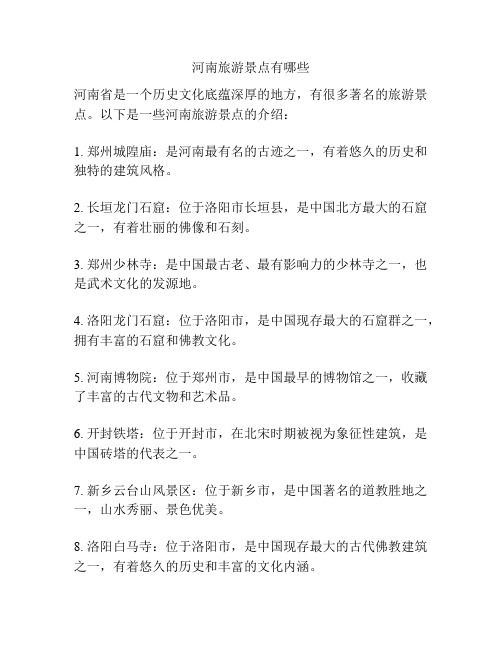
河南旅游景点有哪些
河南省是一个历史文化底蕴深厚的地方,有很多著名的旅游景点。
以下是一些河南旅游景点的介绍:
1. 郑州城隍庙:是河南最有名的古迹之一,有着悠久的历史和独特的建筑风格。
2. 长垣龙门石窟:位于洛阳市长垣县,是中国北方最大的石窟之一,有着壮丽的佛像和石刻。
3. 郑州少林寺:是中国最古老、最有影响力的少林寺之一,也是武术文化的发源地。
4. 洛阳龙门石窟:位于洛阳市,是中国现存最大的石窟群之一,拥有丰富的石窟和佛教文化。
5. 河南博物院:位于郑州市,是中国最早的博物馆之一,收藏了丰富的古代文物和艺术品。
6. 开封铁塔:位于开封市,在北宋时期被视为象征性建筑,是中国砖塔的代表之一。
7. 新乡云台山风景区:位于新乡市,是中国著名的道教胜地之一,山水秀丽、景色优美。
8. 洛阳白马寺:位于洛阳市,是中国现存最大的古代佛教建筑之一,有着悠久的历史和丰富的文化内涵。
9. 开封府:位于开封市,是中国现存最完整的古代封建地方行政机构的建筑群之一,是中国历史文化的重要见证。
10. 宝严寺:位于洛阳市,是中国著名的佛教寺庙之一,拥有丰富的佛教文化和历史遗迹。
除了以上景点,河南还有许多其他著名的旅游景点,如洛阳白云山、焦作云台山、安阳殷墟等。
河南著名景区的介绍
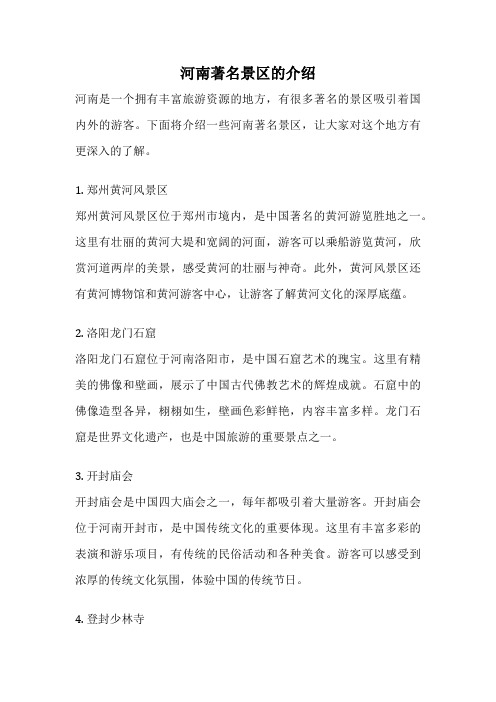
河南著名景区的介绍河南是一个拥有丰富旅游资源的地方,有很多著名的景区吸引着国内外的游客。
下面将介绍一些河南著名景区,让大家对这个地方有更深入的了解。
1. 郑州黄河风景区郑州黄河风景区位于郑州市境内,是中国著名的黄河游览胜地之一。
这里有壮丽的黄河大堤和宽阔的河面,游客可以乘船游览黄河,欣赏河道两岸的美景,感受黄河的壮丽与神奇。
此外,黄河风景区还有黄河博物馆和黄河游客中心,让游客了解黄河文化的深厚底蕴。
2. 洛阳龙门石窟洛阳龙门石窟位于河南洛阳市,是中国石窟艺术的瑰宝。
这里有精美的佛像和壁画,展示了中国古代佛教艺术的辉煌成就。
石窟中的佛像造型各异,栩栩如生,壁画色彩鲜艳,内容丰富多样。
龙门石窟是世界文化遗产,也是中国旅游的重要景点之一。
3. 开封庙会开封庙会是中国四大庙会之一,每年都吸引着大量游客。
开封庙会位于河南开封市,是中国传统文化的重要体现。
这里有丰富多彩的表演和游乐项目,有传统的民俗活动和各种美食。
游客可以感受到浓厚的传统文化氛围,体验中国的传统节日。
4. 登封少林寺登封少林寺位于河南省郑州市,是中国佛教禅宗的发源地之一。
这里有古老的建筑和丰富的文化底蕴,是中国武术的发源地之一。
在少林寺,游客可以参观寺庙建筑、观看僧侣的功夫表演,了解佛教文化和武术文化的交融。
5. 濮阳殷墟濮阳殷墟位于河南濮阳市,是中国商代遗址,也是世界文化遗产。
这里保存着商代的古城遗址和丰富的文物,展示了中国古代文明的瑰宝。
游客可以参观古城遗址和博物馆,了解商代的历史和文化。
6. 南阳汉画馆南阳汉画馆位于河南南阳市,是中国最大的汉画艺术馆。
这里收藏了大量的汉代画作和文物,展示了中国古代绘画的瑰宝。
游客可以欣赏到精美的汉画作品,了解汉代绘画的艺术风格和技法。
以上介绍了一些河南著名景区,每个景区都有其独特的魅力和特色。
无论是自然景观还是人文景观,河南都有很多值得一游的地方。
希望大家能够亲自去河南旅游,亲身体验这些美景和文化。
河南名胜古迹介绍
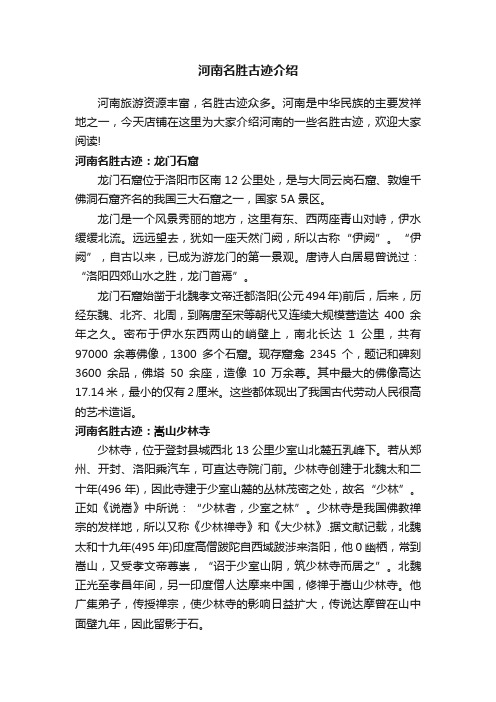
河南名胜古迹介绍河南旅游资源丰富,名胜古迹众多。
河南是中华民族的主要发祥地之一,今天店铺在这里为大家介绍河南的一些名胜古迹,欢迎大家阅读!河南名胜古迹:龙门石窟龙门石窟位于洛阳市区南12公里处,是与大同云岗石窟、敦煌千佛洞石窟齐名的我国三大石窟之一,国家5A景区。
龙门是一个风景秀丽的地方,这里有东、西两座青山对峙,伊水缓缓北流。
远远望去,犹如一座天然门阙,所以古称“伊阙”。
“伊阙”,自古以来,已成为游龙门的第一景观。
唐诗人白居易曾说过:“洛阳四郊山水之胜,龙门首焉”。
龙门石窟始凿于北魏孝文帝迁都洛阳(公元494年)前后,后来,历经东魏、北齐、北周,到隋唐至宋等朝代又连续大规模营造达400余年之久。
密布于伊水东西两山的峭壁上,南北长达1公里,共有97000余尊佛像,1300多个石窟。
现存窟龛2345个,题记和碑刻3600余品,佛塔50余座,造像10万余尊。
其中最大的佛像高达17.14米,最小的仅有2厘米。
这些都体现出了我国古代劳动人民很高的艺术造诣。
河南名胜古迹:嵩山少林寺少林寺,位于登封县城西北13公里少室山北麓五乳峰下。
若从郑州、开封、洛阳乘汽车,可直达寺院门前。
少林寺创建于北魏太和二十年(496年),因此寺建于少室山麓的丛林茂密之处,故名“少林”。
正如《说嵩》中所说:“少林者,少室之林”。
少林寺是我国佛教禅宗的发样地,所以又称《少林禅寺》和《大少林》.据文献记载,北魏太和十九年(495年)印度高僧跋陀自西域跋涉来洛阳,他0幽栖,常到嵩山,又受孝文帝尊崇,“诏于少室山阴,筑少林寺而居之”。
北魏正光至孝昌年间,另一印度僧人达摩来中国,修禅于嵩山少林寺。
他广集弟子,传授禅宗,使少林寺的影响日益扩大,传说达摩曾在山中面壁九年,因此留影于石。
少林寺原有建筑较多,分布较广。
现在少林寺包罗的范围除主体建筑常住院外,还有离寺西不远的塔林,寺西北阜地上的初祖庵,少溪河南岸的南园,钵盂峰下的二祖庵,寺东太室山麓的三祖庵,以及分散在寺周围的古塔、碑刻等。
河南省旅游景点介绍

河南省旅游景点介绍
河南省位于中国中部,拥有丰富的人文历史和自然景观,是一个独具特色的旅游目的地。
以下是一些著名的河南省旅游景点介绍:
1. 郑州-河南省的省会城市,有着深厚的历史底蕴。
您可以参观郑州博物馆,了解河南的古代文化和艺术品。
还可以游览黄河风情区,感受黄河的壮丽景色。
2. 郑州大学-是中国历史最悠久的国立综合性大学之一,校园环境宜人,建筑风格独特,著名的景点包括“五四广场”、“百花园”和“梅园”。
3. 银杏广场-位于郑州市内的一个著名景点,每年11月底至12月初,银杏树叶会变成金黄色,覆盖整个广场,景色非常美丽。
4. 洛阳-洛阳有着悠久的历史和文化遗产。
您可以参观龙门石窟,这是中国古代石窟艺术的杰作之一。
还可以游览白马寺,是中国佛教历史上的重要寺庙。
5. 开封-开封是中国七大古都之一,有着悠久的历史和文化。
您可以参观开封府,了解开封的历史变迁。
还可以游览汴京大观,这是北宋时期的皇家宫殿,保存完好。
6. 豫东河南-这个地区有着美丽的自然风光。
您可以游览云台山,这是中国五岳之一,山脉雄伟壮观。
还可以到嵩山,这是
中国的五岳之一,有着悠久的佛教文化。
以上只是河南省旅游景点的一部分,河南省还有许多其他值得一游的地方,如洛阳龙门石窟、云台山、少林寺等等。
无论您对历史文化还是自然风光有兴趣,河南都能满足您的需求。
河南主要景点、红色景点
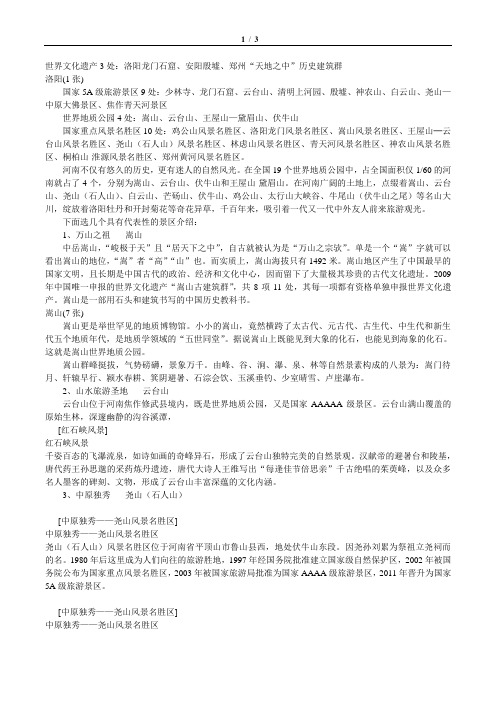
世界文化遗产3处:洛阳龙门石窟、安阳殷墟、郑州“天地之中”历史建筑群洛阳(1张)国家5A级旅游景区9处:少林寺、龙门石窟、云台山、清明上河园、殷墟、神农山、白云山、尧山—中原大佛景区、焦作青天河景区世界地质公园4处:嵩山、云台山、王屋山—黛眉山、伏牛山国家重点风景名胜区10处:鸡公山风景名胜区、洛阳龙门风景名胜区、嵩山风景名胜区、王屋山─云台山风景名胜区、尧山(石人山)风景名胜区、林虑山风景名胜区、青天河风景名胜区、神农山风景名胜区、桐柏山-淮源风景名胜区、郑州黄河风景名胜区。
河南不仅有悠久的历史,更有迷人的自然风光。
在全国19个世界地质公园中,占全国面积仅1/60的河南就占了4个,分别为嵩山、云台山、伏牛山和王屋山-黛眉山。
在河南广阔的土地上,点缀着嵩山、云台山、尧山(石人山)、白云山、芒砀山、伏牛山、鸡公山、太行山大峡谷、牛尾山(伏牛山之尾)等名山大川,绽放着洛阳牡丹和开封菊花等奇花异草,千百年来,吸引着一代又一代中外友人前来旅游观光。
下面选几个具有代表性的景区介绍:1、万山之祖-----嵩山中岳嵩山,“峻极于天”且“居天下之中”,自古就被认为是“万山之宗欤”。
单是一个“嵩”字就可以看出嵩山的地位,“嵩”者“高”“山”也。
而实质上,嵩山海拔只有1492米。
嵩山地区产生了中国最早的国家文明,且长期是中国古代的政治、经济和文化中心,因而留下了大量极其珍贵的古代文化遗址。
2009年中国唯一申报的世界文化遗产“嵩山古建筑群”,共8项11处,其每一项都有资格单独申报世界文化遗产。
嵩山是一部用石头和建筑书写的中国历史教科书。
嵩山(7张)嵩山更是举世罕见的地质博物馆。
小小的嵩山,竟然横跨了太古代、元古代、古生代、中生代和新生代五个地质年代,是地质学领域的“五世同堂”。
据说嵩山上既能见到大象的化石,也能见到海象的化石。
这就是嵩山世界地质公园。
嵩山群峰挺拔,气势磅礴,景象万千。
由峰、谷、涧、瀑、泉、林等自然景素构成的八景为:嵩门待月、轩辕早行、颍水春耕、箕阴避暑、石淙会饮、玉溪垂钓、少室晴雪、卢崖瀑布。
河南历史文化,城市景点大全

河南历史文化,城市景点大全河南历史文化丰富,是中原文明的发祥地之一。
从新石器时代开始,这片土地就孕育着璀璨的文化。
河南境内有众多的文化古迹和城市景点,其中最著名的要数郑州、洛阳、开封等城市了。
郑州郑州位于河南中部,是现代化城市和历史文化名城。
城内有众多的历史遗迹和旅游景点。
1. 郑州博物馆郑州博物馆是一座综合型博物馆,展品包括青铜器、陶瓷、玉器、书画、织锦、古代金属器、竹木牙角器、石器、考古文物等,其中以殷墟青铜器和汉墓文物为特色。
2. 黄河风景区黄河风景区位于郑州市五龙口以东,是国家AAAAA级风景区,涵盖了河南省西部、山西省南部和陕西省东南部的135公里黄河河段。
其内有桥山、黄河、游人山三大景区,素有“中华第一景”之称。
3. 郑州城市广场郑州城市广场位于郑州市的中心位置,是当地居民休闲、娱乐、购物的首选场所之一。
广场内设有电话亭、报亭、售货亭等多个服务设施。
洛阳洛阳是中国七大古都之一,有着悠久的历史和文化底蕴,地处河南中北部。
在这里,你可以深入了解中国的历史和文化。
1. 龙门石窟龙门石窟是中国古代高水平的艺术品。
它始建于北魏元恭年间,历经17个朝代,拥有洛阳全部古代石窟中最大规模的壁画群。
2. 白马寺白马寺建于东汉末年,有着2500多年的历史。
它是中国佛教的发源地之一,也是中国佛教史上的早期宗派、早期佛教文化和佛教艺术的代表之一。
3. 马陵山马陵山位于洛阳市东南部,是中国历史上的重要地区。
境内有许多名胜古迹,如周代的古墓群、东汉名将马援墓和金代的万佛寺等。
开封开封是中国历史文化名城,是中国第一批著名的历史文化名城之一。
在这里,旅行者可以深入了解中国古代以及它的文化沿革。
1. 开封府开封府是中国第一个联合国教科文组织命名的世界文化遗产,在中国历史上占有重要地位。
这里保存了很多宋代官署建筑和文化遗产,包括铁塔、古代官署、游泳池、苏堤、龙亭等。
2. 神仙洞神仙洞是一处著名的古代景点,位于开封的龙亭山中。
河南旅游攻略景点大全

河南旅游攻略景点大全1. 洛阳洛阳位于河南省中部,是中国历史文化名城之一。
它拥有丰富的历史遗迹和自然风光,吸引着众多的游客前来观光。
以下是洛阳的一些著名景点:•龙门石窟:是中国四大石窟之一,被誉为东方的雕刻艺术宝库,被列入世界文化遗产名录。
•白马寺:是中国佛教开山祖庭之一,拥有悠久的历史和深厚的文化底蕴。
•洛阳博物馆:是中国四大博物馆之一,收藏了丰富的历史文物,展示了洛阳的历史和文化。
•洛阳国家森林公园:是洛阳市的市级风景名胜区,拥有美丽的自然风光和丰富的植物资源。
2. 郑州郑州是河南省的省会,也是中国中部地区的重要城市。
郑州具有悠久的历史和独特的文化,以下是郑州的一些著名景点:•嵩山少林寺:是中国佛教禅宗的发源地,也是世界文化遗产和重要的旅游景点之一。
•黄河游览区:位于郑州市东南部,是黄河流经河南省的重要景区,拥有壮丽的黄河风景和丰富的历史文化。
•郑州博物馆:是河南省最大的博物馆,收藏了大量的历史文物,展示了郑州的历史和文化。
•宏光寺:是郑州市的一座佛教寺庙,具有深厚的历史和文化底蕴。
3. 开封开封是河南省中部的一个古老城市,是中国七大古都之一。
开封保留了许多古老的建筑和历史文化遗迹,以下是开封的一些著名景点:•龙亭公园:是中国最早的皇家园林之一,建于北魏时期,是开封的标志性景点。
•大相国寺:是中国现存最早的木结构建筑,具有重要的历史和文化价值。
•清明上河园:是中国著名的民俗风景区,展示了宋代开封城市的真实面貌。
•开封府:是开封市的历史文化名胜区,拥有丰富的历史遗迹和建筑。
4. 驻马店驻马店位于河南省的西南部,是一个以农业为主的城市。
尽管驻马店在旅游方面相对较为欠发达,但也拥有一些值得一游的景点:•嵖岈山:是中国唯一的半岛山和驻马店市的地理标志,山上有瀑布、溶洞等自然景观。
•驻马店市博物馆:收藏了驻马店市的历史文物和文化遗产,展示了该地区的历史和文化。
•涂山古镇:是驻马店市的一个古镇,保留了很多古建筑,具有浓厚的历史和文化氛围。
描写河南旅游景点

描写河南旅游景点
河南作为中国历史文化名城之一,拥有众多著名的旅游景点。
下面是一些河南旅游景点的描写:
1. 郑州黄河风景区:位于郑州市东南部的黄河边上,景区拥有壮丽的黄河大堤和辽阔的河岸平原。
游客可以欣赏到黄河的壮美景色,还可以体验黄河漂流、乘坐云台山风景区的缆车等活动。
2. 郑州嵩山少林寺:嵩山位于郑州市西南部,是中国佛教禅宗的发源地之一。
少林寺作为嵩山的代表景点,吸引了众多的游客。
这里有古老的建筑和壮丽的自然风景,还有著名的少林功夫表演。
3. 洛阳龙门石窟:位于洛阳市东南部的龙门山上,是中国古代石窟艺术的杰作之一。
景区有大量的石窟和雕刻艺术作品,包括佛像、壁画等。
游客可以在这里领略到中国古代艺术的魅力。
4. 洛阳白马寺:位于洛阳市中心的白马山上,是中国佛教的重要寺庙之一。
寺庙建筑古老典雅,风景优美。
这里还有著名的百尺塔和观音殿,吸引了众多的信徒和游客。
5. 开封大宋皇宫遗址:位于开封市中心的皇城内,是中国古代皇宫的遗址之一。
这里保留着大量的古建筑和文物,包括皇宫的殿堂、园林和宫廷建筑等。
游客可以在这里感受到中国古代宫廷文化的魅力。
以上仅为河南旅游景点的一部分,河南还有许多其他的著名景点,如洛阳龙门石窟、安阳殷墟、云台山等。
来到河南旅游,游客不仅可以欣赏到美丽的自然风景,还可以领略到丰富的历史文化底蕴。
河南关于人文的景点

河南关于人文的景点1. 少林寺地点:河南省郑州市嵩山五乳峰下简介:因坐落于嵩山腹地少室山茂密丛林之中,故名“少林寺”。
是中国佛教禅宗的发源地,也是中国著名的武术胜地,以少林武术而闻名于世。
2. 龙门石窟地点:河南省洛阳市洛龙区简介:是世界文化遗产,有着丰富的佛教艺术和石刻艺术。
石窟内有大量精美的佛像和壁画,是了解中国古代佛教艺术的重要场所。
3. 白马寺地点:河南省洛阳市老城以东12公里,洛龙区白马寺镇内简介:现存的遗址古迹为元、明、清时所留。
寺内保存了大量元代夹纻干漆造像如三世佛、二天将、十八罗汉等,弥足珍贵。
4. 关林地点:河南省洛阳市洛龙区关林镇简介:全国重点文物保护单位,国家4A级旅游景区,为埋葬三国时蜀将关羽首级之地。
前为祠庙,后为墓冢,是中国唯一的冢、庙、林三祀合一的古代经典建筑。
5. 铁塔地点:河南省开封市北门大街铁塔公园的东半部简介:供奉释迦摩尼舍利子一颗。
铁塔始建于公元1049年,是1961年中国首批公布的国家重点保护文物之一,素有“天下第一塔”之称。
6. 洛阳老君山地点:河南省洛阳市栾川县简介:又名景室山,是伏牛山三大主峰之一。
老君山气势雄浑,"驻足峰巅,放眼四顾,可西瞻秦阙,南望楚地,北眺龙门,东瞰少林"。
7. 焦作云台山地点:河南省焦作市修武县境内简介:是国家级风景名胜区、国家首批5A级旅游景区和全球首批世界地质公园。
云台山有丰富的人文景观和厚重的历史文化底蕴。
8. 洛阳龙潭大峡谷地点:河南省洛阳市新安县石井镇龙潭沟村简介:是一条由紫红色石英砂岩经流水追踪下切形成的U型峡谷,景区的六大自然谜团、七大幽潭瀑布和八大奇观令人惊叹不已。
9. 驻马店嵖岈山地点:河南省驻马店市遂平县简介:嵖岈山风景区是国家AAAA级旅游区,同时也是《西游记》的创作地、央视《西游记》续集的主要外景拍摄基地。
10. 安阳殷墟地点:河南省安阳市境内简介:是世界文化遗产,中国商代晚期的都城。
河南景点大全

河南景点大全河南是中国历史文化名城之一,拥有丰富的旅游资源和独特的自然风光。
以下是一份关于河南景点的大全,带您领略这个古老而美丽的省份的魅力。
1. 龙门石窟:位于洛阳市,是中国著名的石窟艺术宝库。
龙门石窟以其精湛的艺术造诣而闻名于世,被誉为中国雕塑艺术史上的瑰宝之一。
2. 白云山:位于郑州市,在中国道教史上占有重要地位。
白云山以其奇特的山形和壮丽的自然景色而闻名,是爱好登山和观光的好去处。
3. 郑州黄河风景名胜区:位于郑州市,是黄河最著名的河道风光之一。
在这里,您可以欣赏到黄河壮丽的景色,并了解到黄河的文化底蕴。
4. 洛阳博物馆:位于洛阳市,是中国重要的博物馆之一。
洛阳博物馆以其丰富的文物和珍稀的艺术品而闻名,展示了河南的历史和文化。
5. 开封府:位于开封市,是中国历史上著名的古代县治。
开封府以其庄严的建筑和丰富的历史背景而闻名,是了解中国古代政治文化的重要场所。
6. 嵩山少林寺:位于登封市,是世界上最著名的佛教寺庙之一。
少林寺以其独特的武术文化和古老的佛教传统而闻名,吸引了无数的游客和武术爱好者。
7. 洛阳牡丹园:位于洛阳市,是中国著名的花卉景点之一。
洛阳牡丹园以其广泛种植的牡丹和丰富多样的花卉而闻名,每年吸引了大量的游客前来观赏和拍摄。
8. 郑州博物馆:位于郑州市,是中国重要的博物馆之一。
郑州博物馆展示了郑州和河南地区丰富多样的历史文化,是了解河南历史的重要场所。
9. 宝丰矿山:位于宝丰县,是中国煤炭工业的代表之一。
宝丰矿山以其庞大的规模和丰富的煤炭资源而闻名,是了解中国能源工业的重要场所。
10. 洛阳龙门石窟:位于洛阳市附近的龙门山上,是龙门石窟的一部分。
洛阳龙门石窟以其精美的佛像和壁画而闻名,被誉为中国佛教艺术的瑰宝之一。
11. 郑州植物园:位于郑州市,是郑州最大的植物园。
郑州植物园以其丰富多样的植物和美丽的景观而闻名,是郑州市民休闲和散步的好去处。
12. 洛阳中原文化广场:位于洛阳市中心,是洛阳最繁华的商业区之一。
河南省有哪些著名的旅游景点
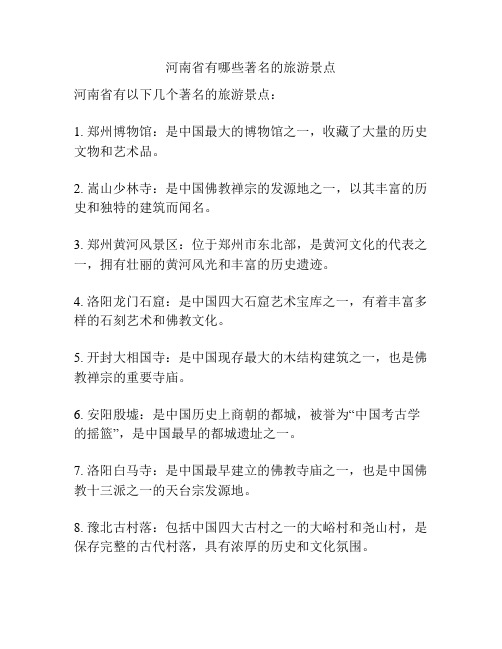
河南省有哪些著名的旅游景点
河南省有以下几个著名的旅游景点:
1. 郑州博物馆:是中国最大的博物馆之一,收藏了大量的历史文物和艺术品。
2. 嵩山少林寺:是中国佛教禅宗的发源地之一,以其丰富的历史和独特的建筑而闻名。
3. 郑州黄河风景区:位于郑州市东北部,是黄河文化的代表之一,拥有壮丽的黄河风光和丰富的历史遗迹。
4. 洛阳龙门石窟:是中国四大石窟艺术宝库之一,有着丰富多样的石刻艺术和佛教文化。
5. 开封大相国寺:是中国现存最大的木结构建筑之一,也是佛教禅宗的重要寺庙。
6. 安阳殷墟:是中国历史上商朝的都城,被誉为“中国考古学的摇篮”,是中国最早的都城遗址之一。
7. 洛阳白马寺:是中国最早建立的佛教寺庙之一,也是中国佛教十三派之一的天台宗发源地。
8. 豫北古村落:包括中国四大古村之一的大峪村和尧山村,是保存完整的古代村落,具有浓厚的历史和文化氛围。
以上是河南省的一些著名旅游景点,每个景点都有其独特的历史和文化价值,是游客不可错过的地方。
- 1、下载文档前请自行甄别文档内容的完整性,平台不提供额外的编辑、内容补充、找答案等附加服务。
- 2、"仅部分预览"的文档,不可在线预览部分如存在完整性等问题,可反馈申请退款(可完整预览的文档不适用该条件!)。
- 3、如文档侵犯您的权益,请联系客服反馈,我们会尽快为您处理(人工客服工作时间:9:00-18:30)。
1.少林寺少林寺位于登封市西12公里处的嵩山五乳峰下,因寺处嵩山少室密林之中,故名“少林寺”,意为“深藏于少室山下密林中的寺院”。
少林寺建于北魏太和十九年(公元495年),是孝文帝为安顿印度高僧跋陀而建。
北魏孝昌三年(公元527年),印度高僧菩提达摩来到少林,在少室山五乳峰一天然石洞面壁九年,首传禅宗。
是我国久负盛名的佛教寺院,声誉显赫的禅宗祖庭,少林功夫的发祥地。
2007年“少林寺景区”被授予中国国家5A级旅游景区,2010年8月1日,包括少林寺常住院、塔林和初祖庵在内的“登封‘天地之中’历史古迹群”被列为世界文化遗产。
Shao Lin Temple is situated at the western foot of Songshan Mountain, 12 kilometers northwest to Dengfeng City, Henan Province. Against the backdrop of Wuru Peak of Shaoshi Mountain, it is surrounded with forests and hills as its natural defense. The “Shao”in “Shaolinsi”refers to “Shaoshi Mountain”; “lin”means "forest” and si “temple”. The name of Shaolin Temple literally means "temple in the woods of Shaoshi Mountain". Shaolin Temple was established in 495A.D. The then Emperor Xiaowen of the Northern Wei dynasty (386-557) had the temple built to accommodate the Indian master Batuo (Buddhabhadra). In 527, the Indian monk Bodhidharma arrived at Shaolin Temple. He spent nine years meditating in a cave of the Wuru Peak and initiated the Chinese Chan tradition at Shaolin Temple. Thereafter, Bodhidharma was honored as the first Patriarch of Chan Buddhism. As Chinese Kungfu also originated from Shaolin Temple, it has been recognized as the origin of Chan Buddhism and the cradle of Kungfu. Shaolin Temple was listed as the national AAAAA tourist scenic spot in 2007, and its famed Pagoda Forest were inscribed as a UNESCO World Heritage Site in 2010 as part of the "Historic Monuments of Dengfeng."2. 龙门石窟龙门石窟位于洛阳市区南面12公里处,是与大同云岗石窟、敦煌千佛洞石窟齐名的我国三大石窟之一。
龙门是一个风景秀丽的地方,这里有东、西两座青山对峙,伊水缓缓北流。
远远望去,犹如一座天然门阙,所以古称“伊阙”。
龙门石窟开凿于魏孝文帝迁都洛阳之际(公元493年),之后历经东魏、西魏、北齐、隋、唐、五代、宋等朝代400余年的营造,其中北魏和唐代大规模营建有140多年,从而形成了南北长达1公里、具有2300余座窟龛、10万余尊造像、2800余块碑刻题记的石窟遗存。
在龙门的所有洞窟中,北魏洞窟约占30%,唐代占60%,其他朝代仅占10%。
龙门石窟中最大的佛像卢舍那大佛,通高17.14米,头高4米,耳长1.9米;最小的佛像在莲花洞中,每个只有2厘米。
The Longmen Grottoes are located 12 kilometres south of present day Luoyang in Henan province. Along with the Mogao Caves(in Gansu Province) and Yungang Grottoes(in Shanxi Province), the Longmen Grottoes are one of the three most famous ancient sculptural sites in China. The Yi River flows northward between Xiangshan and Longmenshan mountains. The area used to be called Yique because it resembles a natural gate of the Yi River seen from a distance. The construction of the Longmen Grottoes began in 493 when the reign of Emperor Xiaowen relocated theircapital at Luoyang and continued through the successive seven dynasties, including Tang and Song, for a span of over 400 years. There are as many as 100,000 statues within the caves. The area also contains nearly 2,300 niches, 2,800 stelae and inscriptions. The biggest statue in Longmen Grottoes is 17.14 meters high, the height of its head is 4 meters and its ears are 1.9 meters long. The smallest ones is in The Lotus Cave, some is as short as 2 centimeters. Situated in a scenic natural environment, the caves were dug from a 1 kilometre stretch of cliff running along both banks of the river. 30% date from the Northern Wei Dynasty and 60% from the Tang, caves from other periods accounting for only 10% of the total.龙门石窟是佛教文化的艺术表现,但它也折射出当时的政治、经济以及文化时尚。
石窟中保留着大量的宗教、美术、建筑、书法、音乐、服饰、医药等方面的实物资料,对中国石窟艺术的创新与发展做出了重大贡献。
2000年11月,联合国教科文组织将龙门石窟列入《世界文化遗产名录》,世界遗产委员会评价:龙门地区的石窟和佛龛展现了中国北魏晚期至唐代(公元493年~907年)期间,最具规模和最为优秀的造型艺术。
这些详实描述佛教中宗教题材的艺术作品,代表了中国石刻艺术的最高峰。
Longmen Grottoes are artistic expressions of Buddha culture, it also reflects the then politics, economy and culture. Numerous materials about religion, art, construction, calligraphy, music, dress and medicine are reserved in the caves, making great contributions to the development of the art of grottoes. In 2000 the site was inscribed upon the UNESCO World Heritage List as “an outstanding manifestation of human artistic cre ativity,” for its perfection of an art form, and for its encapsulation of the cultural sophistication of China from Northern Wei Dynasty to Tang Dynasty (493- 907).3. 白马寺白马寺位于河南洛阳城东10公里处,号称“中国第一古刹”,是佛教传入中国后第一所官办寺院。
它建于东汉明帝永平11年(公元68年),距今已有近2000年的历史。
White Horse Temple, 10 kilometers east of Luoyang, Henan Province, is the first Buddhist temple in China and the first temple built since Buddhism spread to China in the Han Dynasty (206BC-220AD). It was established in 68 AD under the patronage of Emperor Ming in the Eastern Han capital Luoyang,dating back to 2000 years ago.相传汉明帝刘庄夜寝南宫,梦金神头放白光,飞绕殿庭。
次日得知梦为佛,遂遣使臣蔡愔、秦景等前往西域拜求佛法。
蔡、秦等人在月氏(今阿富汗一带)遇上了在该地游化宣教的天竺(古印度)高僧迦什摩腾、竺法兰。
